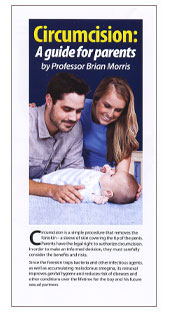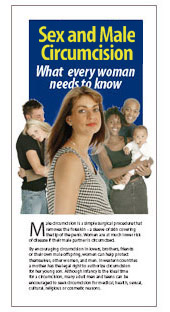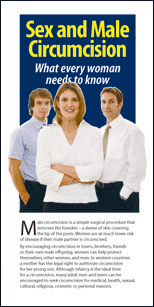Circumcision - Why the Foreskin
Increases Infection Risk
As a prelude to this, one needs to first understand the anatomy. The foreskin is composed of an outer layer that is keratinized (as is skin generally), and an inner lining that is a mucosal surface. The inner lining thus resembles other mucosal epithelia such as constitute the cervix, nasal passages and rectum. It had been suggested that the foreskin protected the glans from drying out and becoming keratinized. However, histological examination has shown the same amount of keratin in the skin of the head of the penis irrespective of circumcision status [Szabo & Short, 2000]. Interestingly, whereas most consider the inner foreskin to be thinner, one study has reported there is no difference between the keratinization of the inner and outer foreskin [[Dinh et al., 2010]. This study was, however, flawed because (1) the foreskins studied were from men circumcised for a medical indication, where balanitis, infections and phimosis could have made the keratin layer of the inner foreskin thicker, and (2) the authors do not indicate what part of the foreskin they studied, where inner foreskin is thinner close to the base at the coronal sulcus than at the distal end [R.H. Gray and R.C. Bailey, personal communication].
The inner layer of the foreskin lines a ‘preputial sac’, which becomes a repository for shed cells, secretions, and urinary residue that accumulates [Parkash et al., 1973; Cold & Taylor, 1999]. It is also a hospitable environment for the growth of bacteria and other microorganisms.
During an erection the head and shaft of the penis extend so that the inner layer becomes exteriorized along the distal half of the shaft. This exposes it to infectious agents during sexual intercourse.
It has been speculated that the foreskin is a source of secretions, pheromones, etc, but given the dubious authorship of these reports and the absence of any research support, such suggestions should be regarded as fanciful. In fact, for references that cite evidence to the contrary see [Waskett & Morris, 2008].
It has been suggested [Caldwell & Caldwell, 1996] that the increased risk of infection in the uncircumcised may be a consequence of the following:
• The foreskin presents the penis with a larger surface area.
• It has been suggested that the moist inner lining of the foreskin represents a thinner epidermal barrier than the more cornified outer surface of the foreskin and the rest of the penis, including the glans. It should be noted that the glans of a circumcised and an uncircumcised penis have the same amount of keratin (i.e., similar skin thickness and protection from invasion of microorganisms) [Szabo & Short, 2000]. Although the keratin thickness of the inner and outer foreskin was suggested to be similar [[Dinh et al., 2010], the samples used were from men with pathology that could have increased keratin thickness, and could have been from the thicker distal end of the foreskin. The thin, moist inner lining may be a potential entry point into the body for viruses and bacteria, but more information is needed on how this occurs. (A photograph of a histological section that illustrates the much thinner inner than outer foreskin can be found later, in the section on the AIDS virus.)
• The presence of a prepuce is likely to result in greater microtrauma during sexual intercourse, thereby permitting an entry point into the bloodstream for infectious agents.
• The warm, moist mucosal environment under the foreskin favours growth of micro-organisms (discussed in detail later). The preputial sac has even been referred to by Dr Gerald Weiss, an American surgeon, as a 'cesspool for infection' [Weiss, 1997], as its unfortunate anatomy wrapped around the end of the penis results in the accumulation of secretions, excretions (urine), dead cells and growths of bacteria as referred to above. Parents are told not to retract the foreskin of male infants, which makes cleaning difficult. Even if optimal cleansing is performed there is no evidence that it confers protection [Wiswell, 1997a; Wiswell, 1997b]. Rather, the foreskin tends to trap and transmit micro-organisms, both to the man himself, and his sexual partners.



